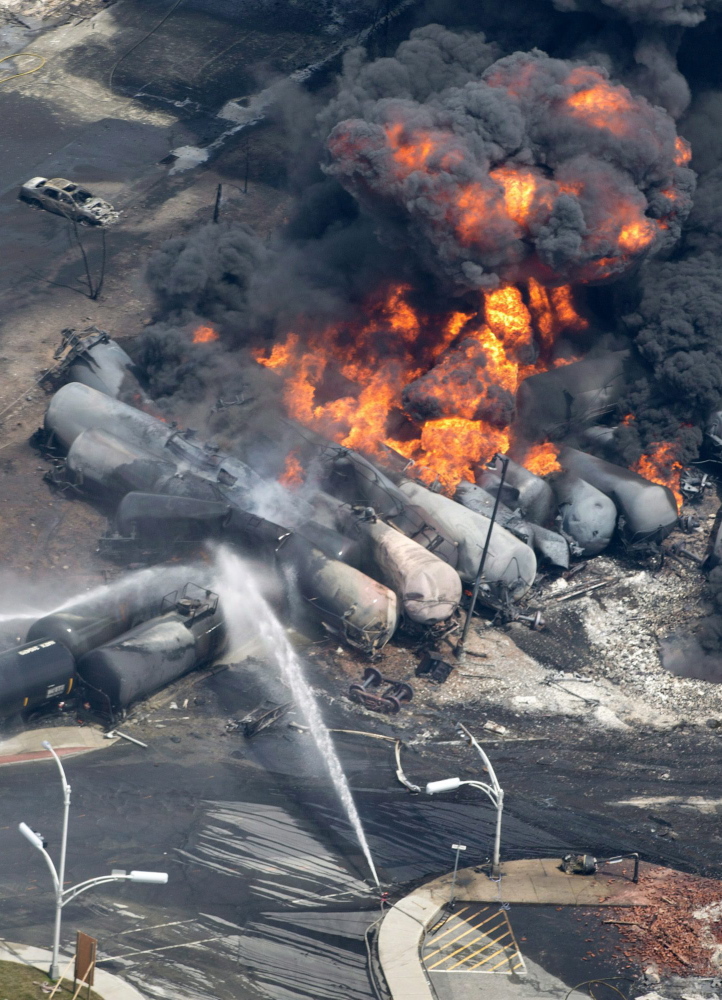DAMARISCOTTA — An accepted media practice is to review tragedies periodically, as with New York’s 9/11 disaster of 2001 and the 2013 Boston Marathon bombing. Nearly 10 months after derailment of a runaway crude-oil train and resulting explosions claimed 47 lives in a small Quebec town, it’s time to assess what should have been learned from this headline-generating debacle.
First, in the stress of the moment, we should not be too quick to judge. All parties, especially the media, feel compelled to search for someone or something responsible, and speculation is rampant. There can either be plenty of blame to go around, or no precedential, factual or fair basis for immediately citing anyone or anything.
In this instance, attention promptly focused on the engineer, seizing on a railroad official’s ill-advised reply to a reporter’s question. Subsequent investigation identified an extensive list of possibilities, including national regulations, company practices, track condition, commodity characteristics, oil owners, cargo loaders, tank-car design and local firefighters.
These factual revelations seldom receive the same exposure as the original speculation. They appear later and less frequently, not on the front pages, and many readers fail to comprehend the full story.
Aside from the parties directly involved, the media and politicians could have conducted themselves more responsibly. Sensational headlines sell newspapers, and elected officials are eager to show they are responding to a situation that might have been avoided. There is an obsession with protecting people from all risks in all places at all times and at all costs. If it’s preventable, we should practice prevention. The problem is predicting what “it” might prove to be. Stuff happens, often without warning.
Contrary to early reports, the cause of the explosive incident was not bad track, since five unmanned locomotives negotiated 7.2 miles of downgrades and curves at excessive speeds without derailing.
The fact that the runaway train’s freight was exceptionally flammable crude oil, unknown to the participating railroads, had everything to do with the eventual disaster, but nothing to do with the release of train brakes. Neither was the single engineer at fault if he followed applicable rules when parking the train.
My belief is that the investigators’ report will confirm suspicion that the incident was triggered by local firefighters’ diligent attempt to extinguish a locomotive blaze by shutting down its engine, inadvertently releasing the train’s air brakes.
Politicians deserve their share of criticism as well. Within four weeks of the incident, barely after Canadian authorities initiated a formal investigation that remains incomplete, congressional legislation was introduced in the U.S. (H.R. 3040) mandating the use of two qualified crew members in the cab of all freight trains, regardless of their cargoes. This response can only be described as shameless pandering to a union constituency anxious to increase membership and dues by creating employment where none is demonstrably needed.
The subject carrier’s labor agreement contained negotiated provisions authorizing single-man operation, and the majority of Amtrak passenger trains are operated by one engineer, assisted by modern alerting and tracking technology. The days when freight trains hauled cabooses and had six crew members are ancient history, and railroad safety is far better for it. Premature, knee-jerk political intervention is not helpful and, as in this case, can be downright embarrassing when election-year grandstanding proves groundless.
The Lac-Megantic catastrophe could have been prevented by several simple operating practices, such as tying down the train at a more level location accessible to a road, placing wheel chocks under the lead locomotive to prevent forward movement or installing a portable device to derail the lead locomotive if the train began to move. Proposals to lock locomotive-cab doors and require more complete end-of-shift sign-offs with train dispatchers are good ones.
Other, more controversial solutions might include limiting the number and placement of hazardous-commodity loads in any train, reducing the allowable speed of such movements, or redeploying tank-car fleets so that crude from high-volatility formations is transported in vessels of the latest, preferred design. Some proposed remedies, like fire-department training throughout the country and accelerating production of rupture-resistant tank cars, will require years to complete.
Domestic rail safety – employee and public – was the best ever in 2013, the result of industry training initiatives and massive capital expenditures on plant and equipment. It’s in railroads’ self-interest to work with regulators to arrive at reasonable, timely, data-based and cost-effective safety enhancements, as the consequences of an extraordinary coincidence of highly improbable circumstances at Lac-Megantic are devastating in all respects.
— Special to the Telegram
Send questions/comments to the editors.



Success. Please wait for the page to reload. If the page does not reload within 5 seconds, please refresh the page.
Enter your email and password to access comments.
Hi, to comment on stories you must . This profile is in addition to your subscription and website login.
Already have a commenting profile? .
Invalid username/password.
Please check your email to confirm and complete your registration.
Only subscribers are eligible to post comments. Please subscribe or login first for digital access. Here’s why.
Use the form below to reset your password. When you've submitted your account email, we will send an email with a reset code.